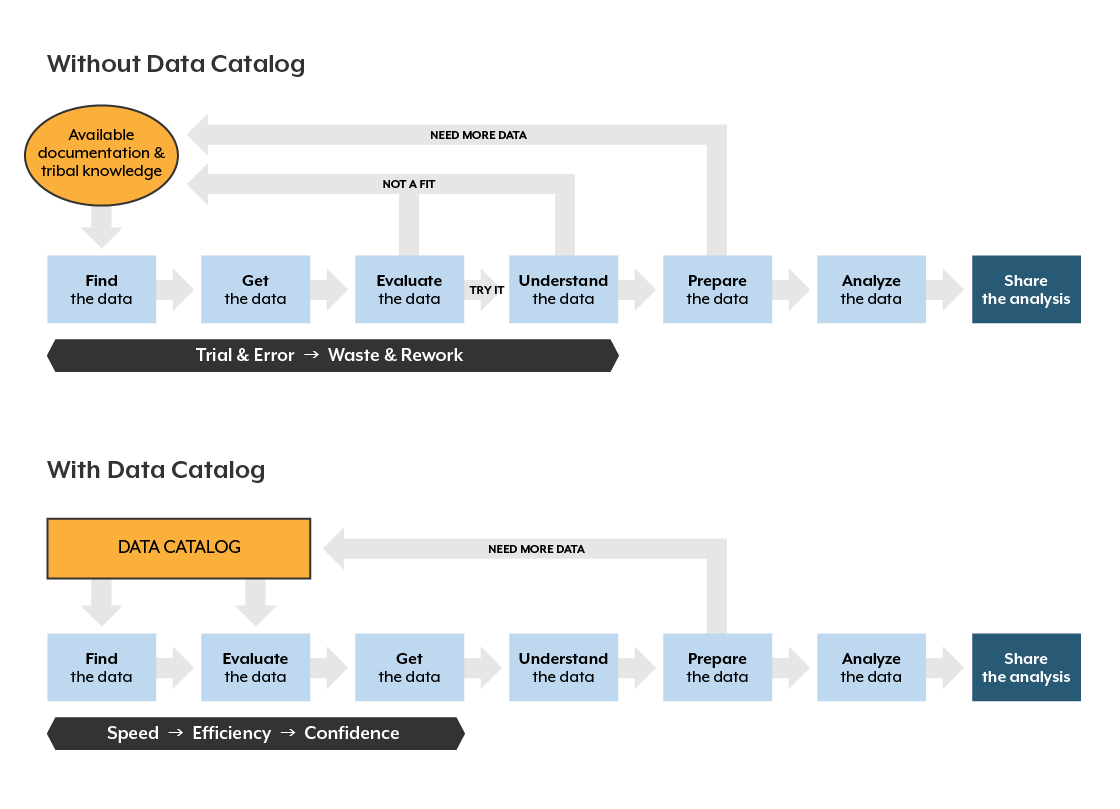Imagine looking for very specific information in a vast library – and you’re up against the clock. Now, contemplate that you don’t even know which book holds the information you need. Pretty horrific, right?
Well, that’s what the situation looks like for companies without a data catalog. Much like how the Dewey system makes finding information at the library easier, a data catalog can help your business discover data insights with ease.
By definition, a data catalog is an organized data inventory that makes it simpler for consumers to locate, evaluate and access data present in a central location.
Data catalogs use metadata to allow users to search the entire information landscape for analytical purposes. A data catalog can maintain an online inventory of data assets by discovering, describing, and organizing information. It provides valuable context that allows engineers, analysts, and data consumers to find and understand relevant data assets.

How to Build Data Catalogs
Building a data catalog can seem like a hugely daunting process due to the level of functionality they offer. The good news is we can break it down into six simple steps.
Step 1
The first step is assessing available metadata across every database your business owns. Identify files, data tables, and databases before incorporating the metadata in the catalog.
Step 2
Every data point should have a description. Add descriptions for each unique data point in the catalog. You can take it one step further by creating profiles so data analysts and consumers can understand the big picture with one glance.
Step 3
Identify any connections between individual data across different databases. Highlighting the relationships between varying data sets will create linkages within the catalog. Consequently, users can enjoy comprehensive search results.
Step 4
The next step is tracking any origin data as well as subsequent transformations over time. By doing so, you’ll have a broader understanding of the original data and can troubleshoot future analytical errors.
Step 5
Your data catalog isn’t complete without data organization. Organize datasets using intuitive systems like sorting and tagging.
Step 6
The last step to creating a data catalog is adding security protocols. Data de-identification, data logs, and access controls are ways to ensure security.
Capabilities a Data Catalog Should Have
The six steps above are the blueprint to creating a data catalog for your business. While most data catalogs can automate the build process, below are the capabilities the final product must have:
- Data access control
- Metadata curation
- Automated data intelligence
- Discovery
- Search and query
- Collaborative data use
How Data Catalogs Can Aid Your Business
According to a recent report from Rubrik, companies without an enterprise-wide data catalog spend up to 66% more on operational costs compared to organizations with one. According to the same report, companies with a data catalog or similar tech enjoyed up to 69% more revenue.
Here are a few ways a data catalog speeds up business efficiency.
Improved Data Control
A data catalog allows users to find data on-demand and to their specifications. Whether for business or analytical purposes, a data catalog offers this level of control.
An effective data catalog works just like a search engine or Amazon’s website. It organizes data warehouses and big data in a manner that makes information relevant and easy to navigate.

Data Accessibility
With many organizations pooling data into huge databases, it can be hard for employees to find the data they need. They’ll spend the bulk of their time and company resources looking for data that should be readily accessible.
A data catalog solves the problem above by making organizational data sets searchable. It enhances accessibility and data identifications.
Say you’re conducting a website audit. The relevant personnel can easily identify what metrics are important to your SaaS website performance and get the data they need by searching through the data catalog.
Reduces Operational Costs
The right data catalog can reduce how much you spend on data organization by up to 50%. Thanks to advances in data organization tech, you have access to super-fast, affordable solutions.
For instance, there’s software that can automatically identify, annotate and tag multiple data employee probationary period template sets. By deploying such technology, you can save money on operational costs for building a data catalog.
Provides a Competitive Edge
Are you looking to gain an edge in a highly competitive industry? A few factors can put you one step ahead such as swift on-demand access to crucial data. A data catalog can provide this access level, thereby allowing you to make informed business decisions, in a heartbeat.
For instance, by identifying and analyzing sales data, you can improve the numbers with guided selling. Furthermore, a data catalog grants you the flexibility to assess the results of new business changes in real-time.
If you’re designing a customer onboarding template, you can tweak the elements and gauge results spontaneously. If there’s a need for any adjustments, you can make them accordingly, backed up with real-time data. With the edge this information brings, you can outperform your competitors.
Data Accuracy
Another advantage a data catalog offers your business is standardization. If every department treats data differently, you’ll end up with a data curation system riddled with errors and inaccuracy.
Plus, you’ll also have to deal with inconsistent data sets. Such inconsistencies can create issues with data identification, modification, and deletion.
On the other hand, a data catalog with a uniform data management method guarantees accuracy. And with accurate information comes increased business efficiency.

Promotes Employee Creativity
While an employee probationary period template can help create a balanced, creative team, data catalogs can also help. When you make it straightforward for employees to access actionable data, you’re making it easier to generate legitimate insights. Plus, a data catalog allows them to test these insights in real-time, spurring innovation and solutions to problems.
Your employees no longer have to sift through unorganized data sets. A data catalog handles the technical details of data management, freeing up your employees to unleash their creativity.
Data Catalogs are the Future
Relying on manpower to maintain organizational data can lead to buried insights and inaccuracies.
If your company is drowning in data sets, take the initiative by investing in a data catalog. Your customers and employees will thank you for it!



